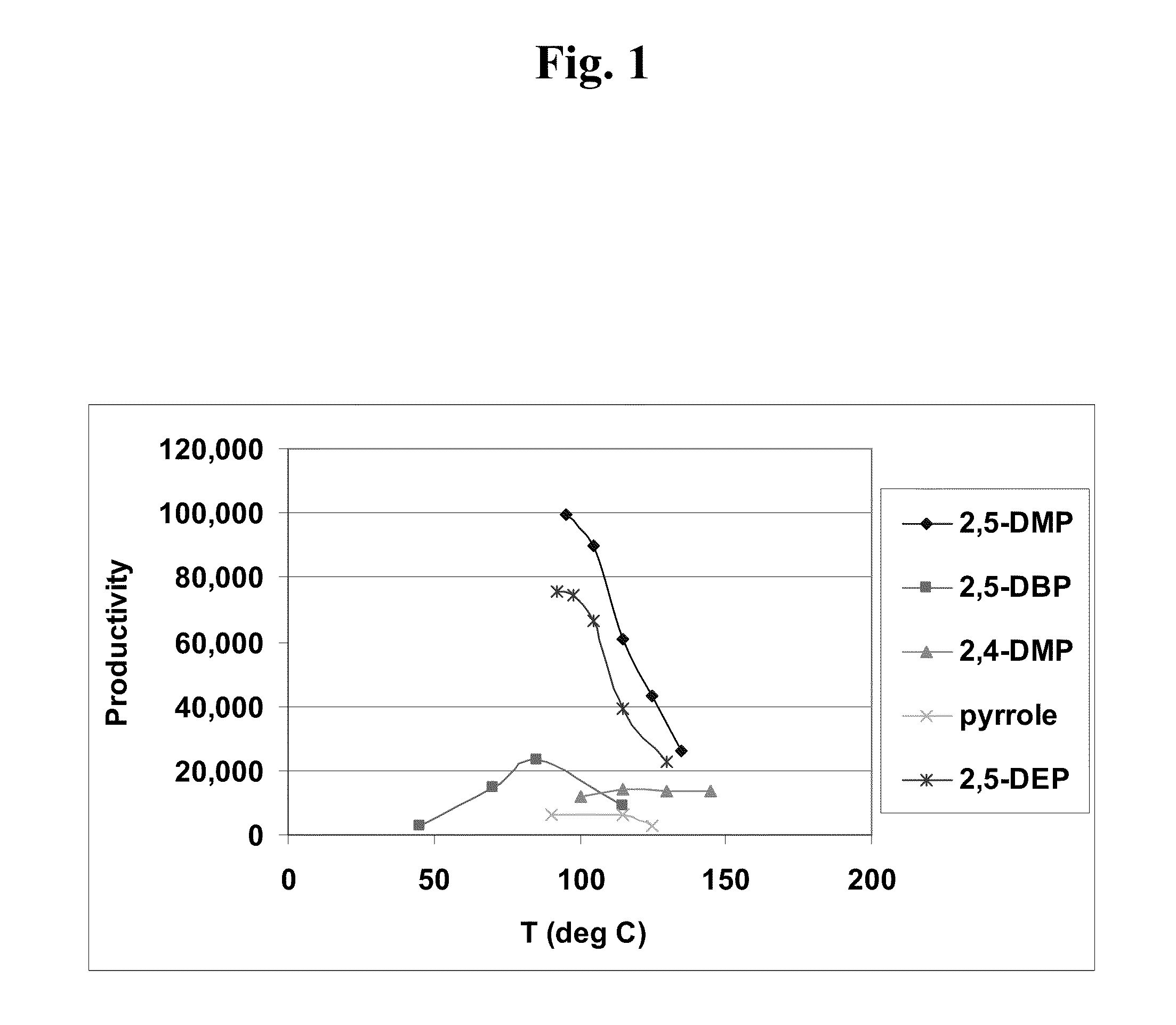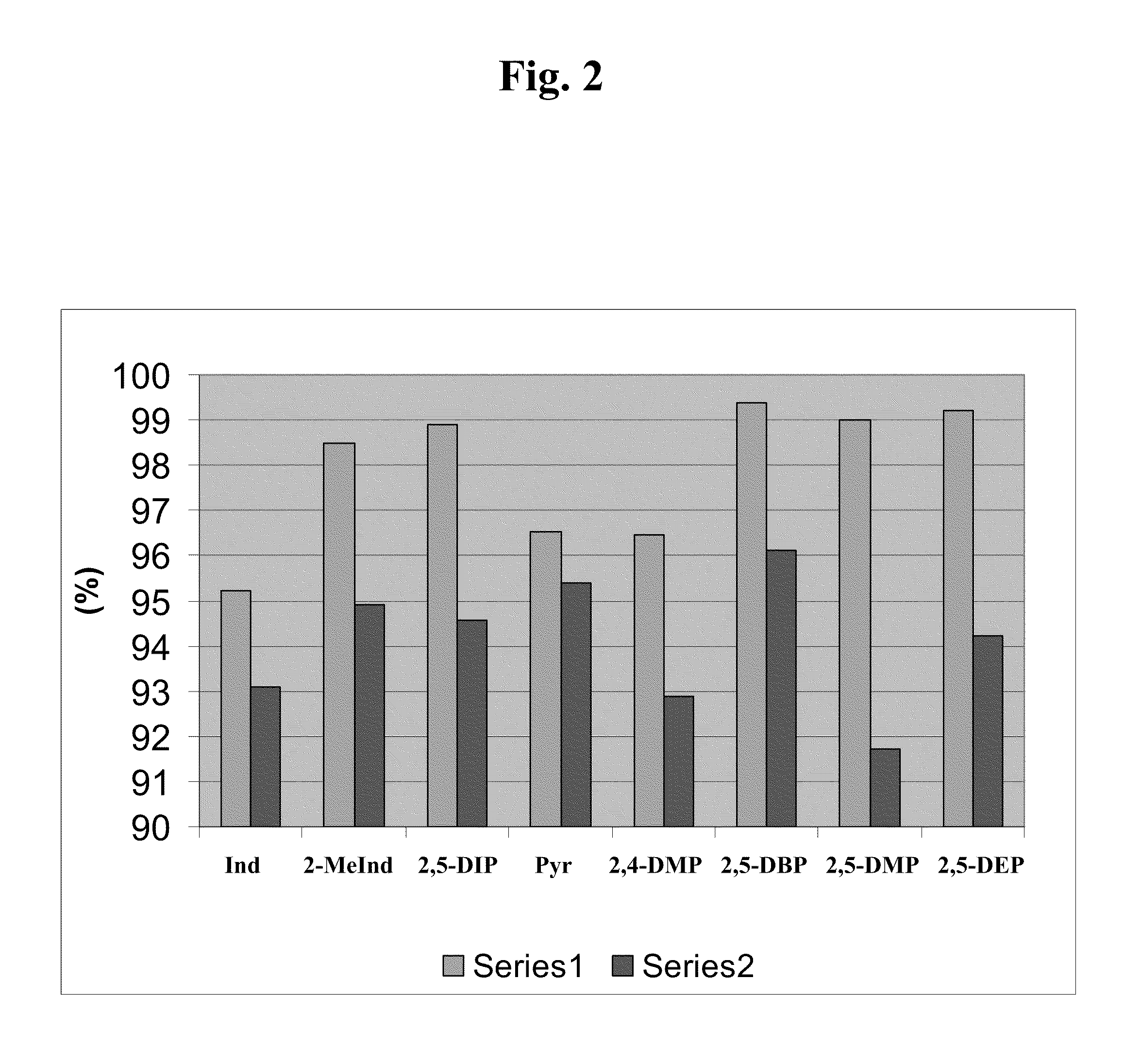Oligomerization catalyst system and process for oligomerizing olefins
a technology of oligomerization catalyst and olefin, which is applied in the direction of catalyst activation/preparation, organic compound/hydride/coordination complex catalyst, physical/chemical process catalyst, etc., can solve the problems of particular preparation, activation, stability, and the method of preparing, activating and using a catalyst system, and achieve good catalyst activity and selectivity.
- Summary
- Abstract
- Description
- Claims
- Application Information
AI Technical Summary
Benefits of technology
Problems solved by technology
Method used
Image
Examples
example 1
Oligomerization Reactions
[0179]Oligomerization reaction studies comparing the catalytic behavior of different pyrroles under standard selective 1-hexene oligomerization reaction conditions, as follows. The standard reactor was a 1 L batch reactor, and oligomerization reactions were carried out at 115-117° C. under 50 psig H2, and under 850 psig ethylene with ethylene uptake on demand, over a 30 minute run time, using 2.5 mg Cr, in 450 mL of cyclohexane. This methodology was useful for identifying various substituted pyrroles that provided reactive catalysts.
example 2
1-Hexene Productivity as a Function of Temperature
[0180]The activity of selected substituted pyrroles and their catalyst systems as described were further investigated. Particularly, catalyst systems that employed 2,5-dibenzylpyrrole (2,5-DBP), 2,5-dimethylpyrrole (2,5-DMP), pyrrole itself, and 2,5-diethylpyrrole (2,5-DEP) were further investigated for their catalytic temperature profile, in which their activity and productivity were examined as a function of temperature. FIG. 1 illustrates a plot of total hexene productivity (g C6 / g Cr) as a function of temperature (° C.), for chromium-based catalyst systems prepared using the following pyrroles: 2,5-dimethylpyrrole (2,5-DMP); 2,5-dibenzylpyrrole (2,5-DBP); 2,4-dimethylpyrrole (2,4-DMP); pyrrole; and 2,5-diethylpyrrole (2,5-DEP). The FIG. 1 productivity versus temperature data are listed in Table 1.
[0181]Among other things, these studies indicated that each pyrrole typically is characterized by its own unique temperature profile, w...
example 3
1-Hexene Productivity as a Function of Pyrrole Substitution
[0183]Table 2 and FIG. 2 provide a comparison of productivities (g C6 / g Cr) for catalyst systems prepared according to Example 1, in which the catalyst system contain the indicated pyrroles. The temperature at the highest observed productivity is also shown.
[0184]Among other things, the data from this Example and FIG. 2 illustrate that 2,5-disubstituted pyrroles provide catalysts with generally higher productivity that those that contain non-2,5-disubstituted pyrroles, that is, pyrroles that do not include substituents at both the 2- and 5-positions, regardless of the other substituents in the pyrrole. Generally, the catalytic productivity was observed to increase on moving from the non-substituted pyrrole, to the 2- or 5-substituted pyrrole (for example, 2,4-dimethylpyrrole), to the prototypical 2,5-dimethylpyrrole. Although some steric congestion at both the 2- and 5-positions appear to be useful, too bulky substituents at...
PUM
| Property | Measurement | Unit |
|---|---|---|
| weight percent | aaaaa | aaaaa |
| molar ratio | aaaaa | aaaaa |
| temperatures | aaaaa | aaaaa |
Abstract
Description
Claims
Application Information
 Login to View More
Login to View More - R&D
- Intellectual Property
- Life Sciences
- Materials
- Tech Scout
- Unparalleled Data Quality
- Higher Quality Content
- 60% Fewer Hallucinations
Browse by: Latest US Patents, China's latest patents, Technical Efficacy Thesaurus, Application Domain, Technology Topic, Popular Technical Reports.
© 2025 PatSnap. All rights reserved.Legal|Privacy policy|Modern Slavery Act Transparency Statement|Sitemap|About US| Contact US: help@patsnap.com



